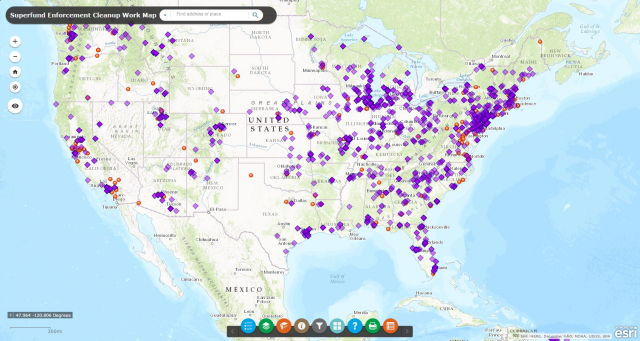Superfund Enforcement FY 2022 Annual Results
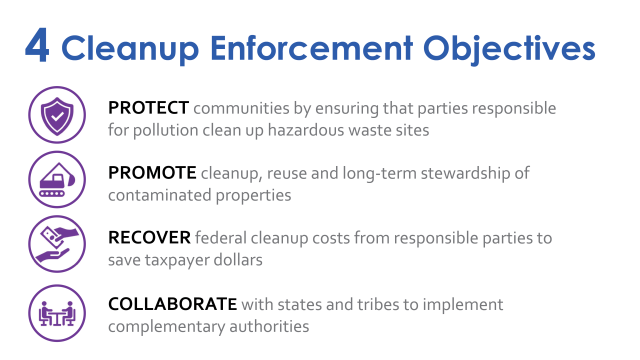
The Superfund enforcement program addresses hazardous waste sites to protect communities by ensuring that the parties responsible for the contamination clean up the sites. Holding polluters accountable and addressing their liability helps to promote the cleanup of contaminated properties and their return to productive use. EPA negotiates settlement agreements with potentially responsible parties (PRPs) or orders PRPs to carry out cleanup work. Superfund enforcement ensures that contaminated sites are addressed while preserving taxpayer dollars and ensuring that Superfund Trust Fund money is available for the Agency to address truly abandoned and orphaned sites. Successful implementation of the Superfund enforcement program requires collaboration with our federal, state, and tribal partners.
In fiscal year (FY) 2022, the Superfund enforcement program accomplishments include:
- Supporting and advancing EPA’s goal of strengthening environmental justice (EJ) at Superfund sites;
- Implementing the “enforcement first” policy, requiring companies or those responsible for contamination to clean up Superfund sites; and
- Addressing liability concerns of parties willing to clean up a site to benefit communities and to promote reuse of contaminated property.
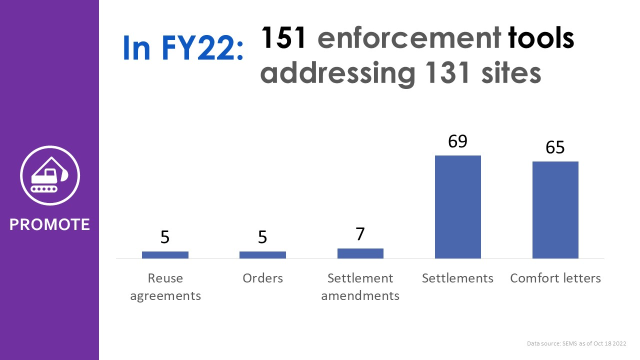
For FY 2022, EPA’s work to require responsible parties to perform and/or pay for cleanup resulted in 74 settlements, five orders, and seven settlement amendments resulting in cleanup commitments valued at $575.0 million (for cleanup work totaling $466.0 million and cost recovery settlements totaling $109.0 million), including $35.3 million from settlements with prospective purchasers and other third parties.
Additionally, EPA issued 65 comfort/status letters across the country to aid in the return of Superfund sites to productive reuse.
The Superfund Enforcement Cleanup Work map below displays the sites across the country currently being cleaned up by responsible parties because of EPA’s enforcement efforts. More information on the Superfund enforcement program is available on the Agency’s website.
On this page:
- Superfund Enforcement Efforts Further Goal of Strengthening Environmental Justice
- Superfund Enforcement Cleanup Case Highlights
- Superfund Enforcement Cleanup Work Map
Superfund Enforcement Efforts Further Goal of Strengthening Environmental Justice

EPA’s Superfund enforcement program is committed to advancing the Agency’s priority to strengthen enforcement to help advance the protection of vulnerable and overburdened communities impacted by pollution. In FY 2022, 69% of Superfund agreements with responsible parties were finalized at sites with potential EJ concerns.
Superfund enforcement environmental justice implementation plan finalized
On April 27, 2022, EPA’s Office of Site Remediation Enforcement and Federal Facilities Enforcement Office issued the “Implementation Plan for Strengthening Environmental Justice in EPA's Cleanup Enforcement Program” to implement the action items outlined in the 2021 memorandum issued by EPA’s Office of Enforcement and Compliance Assurance (OECA) entitled “Strengthening Environmental Justice through Cleanup Enforcement Actions.” OECA’s cleanup enforcement program offices, as well as EPA's regional offices, have made significant progress in strengthening the cleanup enforcement programs' efforts to protect communities impacted by pollution with EJ concerns.
In FY 2022, the Superfund enforcement program:
- Continued efforts to issue more robust enforcement instruments to negotiate agreements with responsible parties for performing cleanup work at Superfund sites.
- Encouraged EPA Regions to require responsible parties to take early cleanup actions.
- Added new language for enhanced community engagement to Comprehensive Environmental Response, Compensation, and Liability Act (CERCLA) model settlement documents and the model Statement of Work for investigation work at sites regarding the inclusion of community impact mitigation activities in Statements of Works (SOWs). These provisions are appropriate when the performance of cleanup work itself could potentially impact nearby communities.
- Worked with the Superfund program office to implement a process for EPA Regions to add settlement documents going forward and for the previous five years to site-specific profile webpages.
EPA uses Superfund enforcement instruments when negotiating settlement agreements to ensure national consistency and support timely negotiation of site-specific settlement agreements. More information about cleanup enforcement accomplishments is available on OECA’s EJ accomplishments webpage.
Superfund Enforcement Cleanup Case Examples
The following are examples of significant CERCLA settlement agreements finalized in FY 2022.
Environmental Justice Highlights
Continuation of lead cleanup work and redevelopment at USS Lead Superfund site in Indiana

On September 2, 2022, EPA, the U.S. Department of Justice (DOJ), and the State of Indiana finalized three documents to complete the cleanup work and support redevelopment in the contaminated area known as operable unit 1 (OU 1) of the USS Lead Superfund site in East Chicago, Indiana. The documents are:
- an Explanation of Significant Differences which describes the updated cleanup plan to reflect the City of East Chicago’s 2020 change to the zoning designation of the property from residential to light industrial use;
- a prospective purchaser agreement (PPA) with the property developer, Industrial Development Advantage of East Chicago, LLC, who will implement the cleanup work; and
- an administrative settlement agreement with several of the site’s responsible parties requiring them to provide financial assurance to ensure completion of the cleanup, reimburse EPA $18 million for its past cleanup costs, and pay for future oversight costs by EPA and the state.
The cleanup work addresses soil contaminated with lead and arsenic due to manufacturing activities at several industrial facilities between 1906 and 1985. The communities within and around the site have historically been overburdened by pollution and have expressed concerns particularly about the health risks associated with exposure to lead. The cleanup of residential yards in OU 1 is complete and the three documents ensure that the remainder of the cleanup work performed by the developer is in accordance with the property’s future use. Redevelopment at the site will result in the construction of a modern warehouse and transportation center. For more information, visit the USS Lead Superfund site profile page.
EJ community impact mitigation language included in cleanup agreement for East Helena Superfund site in Montana
On August 1, 2022, a settlement was finalized for a remedial design/remedial action consent decree (RD/RA CD) between EPA, BNSF Railway Company, and Montana Rail to clean up contaminated soil within a two-acre railyard at the East Helena Superfund site in East Helena, Montana, an area of EJ concern. The settlement agreement requires the railroad to include dust and noise mitigation components to avoid impacts on the surrounding community. Use of impact mitigation activities is an important component in OECA’s and DOJ’s strategy to implement the Agency’s prioritization of protecting vulnerable and overburdened communities impacted by pollution.
For more information visit the East Helena Superfund site profile page and the Agency’s webpage on the 2021 RD/RA CD and SOW.
Settlement at Delaware Superfund site addresses drinking water contamination
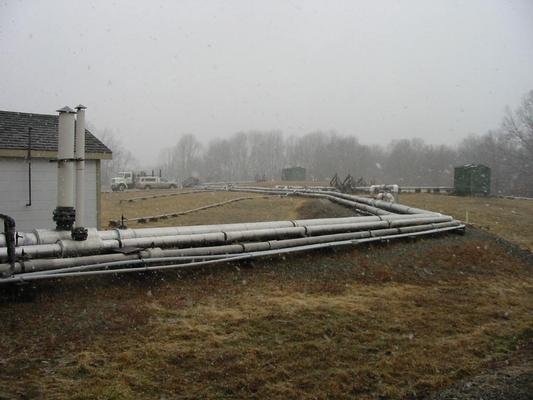
On July 19, 2022, a settlement was finalized with 21 responsible parties to address cleanup work at the Delaware Sand and Gravel Superfund site in New Castle, Delaware. Analysis of the site using EJScreen, the Agency’s EJ mapping and screening tool, found the communities surrounding the site as having potential EJ concerns. The cleanup work will restore contaminated ground water to beneficial use, prevent exposure to site contaminants in drinking water, effectively reduce the release of contaminants from areas within the site, prevent exposure to contaminated soil, and eliminate the potential future exposure to site-related contaminants in indoor air.
Specifically, the cleanup work will address soil and ground water contaminated with polychlorinated biphenyls (PCBs), metals, 1,4-dioxane, bis(2-chloroethyl)ether, and benzene. Seven of the parties will perform the work, valued at $44.6 million, at the 27-acre site. EPA will also receive payments totaling approximately $1.6 million for past and future cleanup work, for a total settlement value of approximately $46.2 million.
Information about the site is available on the Delaware Sand & Gravel Superfund site profile webpage.
Press Release: https://www.epa.gov/newsreleases/us-delaware-settle-21-parties-416-million-cleanup-delaware-sand-gravel-landfill.
Cleanup settlement addresses contamination at Superfund site located within Illinois community with EJ concerns

On February 2, 2022, EPA reached a final settlement to address cleanup PCBs, pesticide, and heavy metal contamination in the soils, sediments, surface water, and ground water at the Sauget Area 2 Superfund site in Sauget, Illinois. The site, located within a community with EJ concerns, is a 312-acre area that includes five inactive disposal areas including three closed landfills, four closed sludge dewatering lagoons, and an abandoned solvent reclamation facility waste disposal site.
Under the settlement between DOJ, EPA, and Pharmacia LLC and Solutia Inc, successor companies to Monsanto Corporation, the companies agreed to: perform work; collect, treat, and dispose of non-aqueous phase liquids; construct asphalt caps over potentially mobile source areas; install solid waste landfill caps; implement vapor intrusion mitigation; and establish institutional controls. Once this source control work is completed, EPA will develop a comprehensive plan to address ground water contamination, which EPA expects responsible parties from previous cleanup settlement agreements to address. For more information, please visit the Sauget Area 2 Superfund site profile webpage.
Press Release: https://www.epa.gov/newsreleases/monsanto-successor-companies-agree-clean-remaining-surface-contamination-sauget.
Promoting Reuse of Cleaned Up Properties
The Superfund enforcement program makes a difference in communities by supporting the cleanup and revitalization of contaminated properties by parties who were not responsible for the contamination. These efforts include implementation of CERCLA’s landowner liability protections and use of site-specific agreements and other enforcement tools to address the Superfund liability concerns of prospective purchasers, local governments, and other parties interested in acquiring and reusing contaminated property.
EPA and Scout DAC reach a PPA to cleanup and reuse last undeveloped tract in Bozeman, Montana
In July 2022, EPA, DOJ, and the State of Montana finalized a PPA with a developer at the Idaho Pole Superfund site in Bozeman, Montana. The site is the last major undeveloped tract of land in Bozeman. The developer, Scout DAC, LLC, plans to acquire approximately 36 acres of the 87-acre site to create commercial and office space and a solar panel farm over an existing on-site consolidated waste soil repository.
The developer will remove and consolidate treated soils from a newly expanded floodplain, provide additional clean cover and cap the necessary portions of the property, take measures such as improving storm water management to protect the cleanup work, and establish a utility corridor to avoid contact with contamination in the property. The value of the cleanup work is $6.5 million. As a result of the PPA, EPA was also able to negotiate a settlement agreement with the responsible parties at the site to address contaminated ground water, which was being done under a unilateral administrative order.
PPA settlement secures long-term steward to implement remedy and support reuse in Colorado
In June 2022, EPA, DOJ, and the State of Colorado finalized a PPA with a developer at the Sand Creek Superfund site in Commerce City, Colorado. The developer, RREEF CPIF 48th & Ivy Owner, LLC, plans to acquire approximately 65 acres of the site for industrial/commercial development. Although the site was deleted from the NPL in 1996, it has remained undeveloped due to the long-term remedy at the site.
Under the PPA, the developer will implement the remedy, valued at $6.5 million, to make the land available for development in a manner that is safe for human health and the environment. In addition, the developer will spend over $600,000 on sustainability, EJ, and equitable development activities, such as improved resource management, low-impact transportation improvements, and truck-traffic management.
Settlement with bona fide prospective purchaser agreement will support investigation of heavy metals contamination in Colorado
In April 2022, EPA and DOJ finalized a bona fide prospective purchaser agreement (BFPPA) with a developer at the Vasquez Boulevard & Interstate 70 Superfund site in Denver, Colorado. Vita Fox North L.P. acquired approximately 41 acres of the 2080-acre site for a mixed-use development. Under the BFPPA, the purchaser will perform site characterization at OU 3 on the site, which will include sampling soils for contaminants of concern and excavating impacted soils for off-site disposal. The value of the work by the purchaser is $8.3 million, and the data collected under the agreement will be used by EPA to perform the remedial investigation/feasibility study.
Prospective lessee agreement to perform removal supports commercial reuse
In March 2022, EPA and DOJ finalized a prospective lessee agreement (PLA) with a prospective lessee to perform cleanup work at the C-Brite Removal Superfund site in Harbor City, California. The prospective lessee, 1213 253rd, LLC, agreed to perform a portion of the Agency’s removal work estimated to cost $345,000 and to pay $80,000 towards EPA’s oversight costs at the site. The prospective lessee intends to reuse the abandoned property as a parking lot for its adjacent business. The PLA also enabled EPA to negotiate a separate ability-to-pay settlement for $100,000 with the current owner of the site to help fund the Agency’s effort to clean up certain hazardous areas of the site in advance of the prospective lessee’s acquisition of the property.
Additional Superfund Enforcement Case Examples
EPA reaches settlement for the cleanup of waste disposal impoundments impacted by Hurricane Ida

On November 15, 2021, a settlement was finalized with Wyeth Holdings LLC, a subsidiary of Pfizer Inc. to clean up the American Cyanamid Superfund site, located in Bridgewater Township, New Jersey. The company is required to perform the remedial cleanup action at the site’s OU 8. In September 2021, remnants of Hurricane Ida caused flooding at the site due to the Raritan River overflowing its banks. The cleanup of these two impoundments will remove this highly toxic portion of the site from potential impact by future flooding events.
The estimated cost for the cleanup work is $69 million. Wyeth will reimburse all of EPA’s oversight costs related to the remedial action work. The cleanup work includes the excavation and off-site shipment for treatment/destruction of acid tar waste contained in two impoundments, the solidification/stabilization of soil and/or clay in the impoundments that was impacted by the acid tar waste, and the placement of a protective cover over the entire area addressed. Under a separate administrative settlement agreement, finalized in September 2019, Wyeth is performing the remedial design for the site, estimated to cost $5 million. Additional site information is available on the American Cyanamid Superfund site profile web page.
Cleanup settlement addresses coal ash soil and water contamination at the Town of Pines Groundwater Plum Superfund site in Indiana
On September 12, 2022, a settlement agreement between EPA, the State of Indiana, and Northern Indiana Public Service Company LLC (NIPSCO) was approved to address cleanup of coal ash contamination at the Town of Pines Groundwater Plum Superfund site in the Town of Pines, Indiana. Soil and ground water contamination resulted from the transportation and disposal of metals from coal combustion residuals (CCR), including fly ash and bottom ash, generated at NIPSCO’s Michigan City Power Generation Station, and later used as landscaping fill. NIPSCO is the state’s largest natural gas distribution company and the second-largest electric distribution company.
The company will investigate soil to identify contamination above cleanup levels excavate and dispose of contaminated soil off-site, restore the excavated properties using clean backfill, and implement institutional controls to prevent exposure to soil contamination left at depth.
The settlement, valued at $12.4 million will also reimburse EPA for its past cleanup costs, as well as reimbursing EPA and the state for its past and future oversight costs. Additionally, NIPSCO will monitor residential drinking water wells, ground water monitoring wells, surface water, and sediments. More information is available from the Town of Pines Groundwater Plum Superfund site profile webpage.
Press Release: https://www.epa.gov/newsreleases/northern-indiana-public-service-company-clean-remaining-surface-contamination-town.
$90+million settlement modification addresses cleanup of lead and arsenic contaminated sediment at New Jersey Sherwin-Williams/Hilliards Creek Site
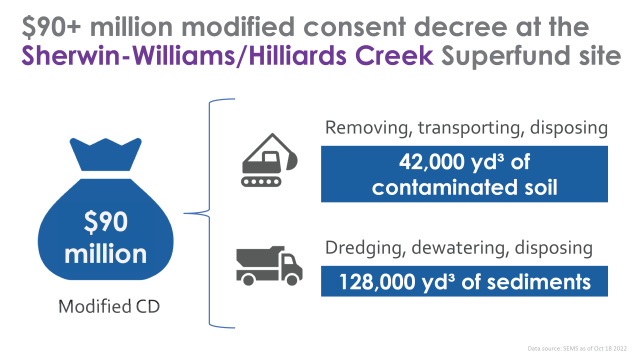
On September 26, 2022, a modification to a 2019 consent decree (CD) with the Sherwin-Williams Company was court-approved to address soil and sediment contamination at the Sherwin-Williams/Hilliards Creek Superfund site located in the Borough of Gibbsboro, Voorhees Township, and Lindenwold in Camden County, New Jersey. The work addressed in the CD modification requires Sherwin-Williams to clean up lead and arsenic contamination of soil and surrounding lakes and pay EPA’s future costs related to implementation of the cleanup plan. The site includes the former manufacturing plant area, which was the location of a large-scale paint, varnish, and lacquer manufacturing facility. The settlement, valued at over $90 million, is the third-highest modification settlement for the Superfund enforcement program.
The cleanup work will remove, transport, and dispose of 42,000 cubic yards of contaminated surface soil within the Hilliards Creek floodplain and, in limited areas, on the south shore of Kirkwood Lake. Deeper contaminated soil within the floodplain of Hilliards Creek will be capped to prevent the contaminants from moving. The cleanup will also dredge, dewater, transport, and dispose of 128,000 cubic yards of contaminated sediment from the lake and creek. Areas disturbed by the cleanup work will be restored and replanted with native plant species. Information on the site is available on the Sherwin-Williams/Hilliards Creek Superfund site profile webpage.
Superfund Enforcement Cleanup Work Map
EPA's Superfund Settlements and Work Order Mapper highlights the current cleanup work taking place at privately and federally owned Superfund sites across the country resulting from the Agency’s enforcement work to negotiate cleanup settlement agreements or issue orders. The data is current through September 30, 2022.
The map contains data on the cleanup work at 869 sites under 1,416 enforcement agreements and orders valued at more than $23.7 billion in estimated cleanup costs.
Visit the Information about the Superfund Cleanup Work Map webpage for the map’s data overview, disclaimer language, and user guide.

